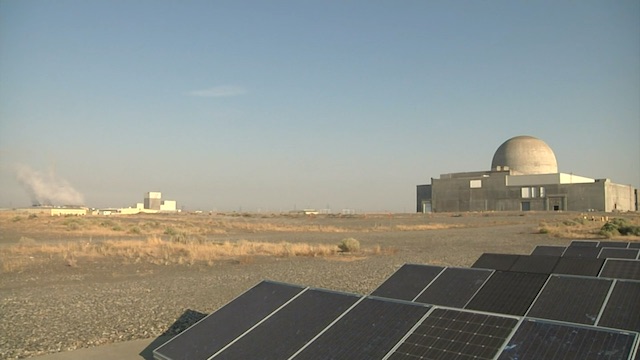forum
library
tutorial
contact

BPA's $500M Windfall Will Mostly Go To Rate Reductions,
Irking Fish, Energy Efficiency Advocates
by Pete DankoPortland Business Journal, January 11, 2023
|
the film forum library tutorial contact |

|
BPA's $500M Windfall Will Mostly Go To Rate Reductions,
by Pete Danko |
 Surplus power sales and high market prices produced a windfall for the Bonneville Power Administration in its 2022 fiscal year -- and a tussle over what to do with $500 million.
Surplus power sales and high market prices produced a windfall for the Bonneville Power Administration in its 2022 fiscal year -- and a tussle over what to do with $500 million.
BPA Administrator John Hairston settled the matter late last week, sticking with a staff proposal to put $350 million into reducing rates for the agency's firm power customers this year, $100 million toward paying down debt and $50 million into fish and wildlife programs.
BPA sells power from 31 federal dams and the Northwest's only commercial nuclear plant and owns and operates 15,000 miles of transmission lines and associated infrastructure, comprising about three-quarters of the region's high-voltage grid.
"Last year's financial performance created this unique opportunity to provide rate relief to our customers and accelerate funding of meaningful mitigation measures that will help fish and wildlife in the region," Suzanne Cooper, BPA's senior vice president of power services, said in a statement.
It's a divvying up that public power agencies who rely greatly on BPA hydropower endorsed, though grudgingly in many cases, and that environmental and energy efficiency advocates criticized.
BPA outlined the decision in a 57-page document recounting and responding to stakeholder critiques. Key among the rationales it offered was that it returned the bulk of benefits of the federal power system to the customers who pay for its costs.
That's often worked against customers in recent years when BPA's financial performance suffered due to rising costs and low market prices that made surplus sales less lucrative.
It also fit with a settlement proposal for rates in 2024 and 2025 that included an agreement by the parties not to challenge the parceling of the big surplus.
That led the Klickitat Public Utility District, for example, to weigh in that it supported the proposal "even though we do not in fact agree any funds should be used for fish and wildlife." In a similar vein, the Kootenai Electric Co-op said it "does not love the ... proposal. We simply support and accept it."
Several utilities emphasized that their agriculture-sector customers, hard hit by increased input costs, needed every dollar of rate relief they could get.
Yet BPA faced calls to use more of the money to boost spending on programs intended to mitigate the effects of the hydropower system on fish. BPA cost-cutting in the last several years exacerbated the need for more immediate investment, activists argued.
"BPA continues its historic approach to short-changing imperiled Northwest salmon as they slide toward extinction in no small part due to the fish-killing dams that BPA operates that generated this huge surplus of funds," Bill Arthur, chair of Sierra Club's Snake River Salmon Campaign, said in a statement.
The $50 million earmark for fish ran counter to Biden administration vows to prioritize new solutions for the longstanding fish challenge, advocates added.
"What we've seen with this recent decision is more business-as-usual," Mitch Cutter of the Idaho Conservation League said. "BPA is nickel-and-diming the Northwest's iconic fish to extinction, profiting off of the very dams that are killing the fish, and the Administration is letting them get away with it."
One notable plea for more money for salmon had come from Kate Brown in her now former role as governor of Oregon, in a Nov. 29 comment submitted on the BPA staff proposal. She alluded to recent debates over how much water should be spilled over the hydro system's dams to aid fish. Doing so can cut into power production, reducing BPA revenues.
"BPA's significant excess revenues indicate much more could have been done for fish without risking cost-efficient power operations," Brown said. "Therefore, I strongly urge the BPA Administrator to significantly increase the proposed allocation for conservation programs. A 10% allocation is simply unacceptable."
BPA rejected Brown's premise.
"Although overall revenues during FY 2022 were higher than forecast, these revenues were largely attributed to a combination of historically high market prices for power and the shape of the rivers' runoff during the spring months of 2022, not as a result of any decision-making on operations related to fish," the agency said in its response.
Other advocates agreed that the majority of the surplus should go to customers, but that the Northwest Power Act demanded a share also go to energy efficiency, or "conservation," as BPA terms it. NW Energy Coalition and the Natural Resources Defense Council noted that energy-efficiency investment planned for the 2024-25 rate period is flat even though "energy efficiency is a key element of the Biden Administration's climate and clean energy strategy."
They wanted $50 million shifted from the $350 million going to customers.
BPA responded that it "stands ready to meet its conservation funding commitments in the future." More broadly, it rejected the idea of using a one-time financial event to make changes to a program that "can impact other processes, such as BPA's resource planning, load and resource forecasting, ratemaking, and multiple other areas of BPA's business."
Related Pages:
BPA's Response to Comments
Related Pages:
BPA Power Rates Falling for First Time in a Decade by Pete Danko, Portland Business Journal, 7/29/21
learn more on topics covered in the film
see the video
read the script
learn the songs
discussion forum
